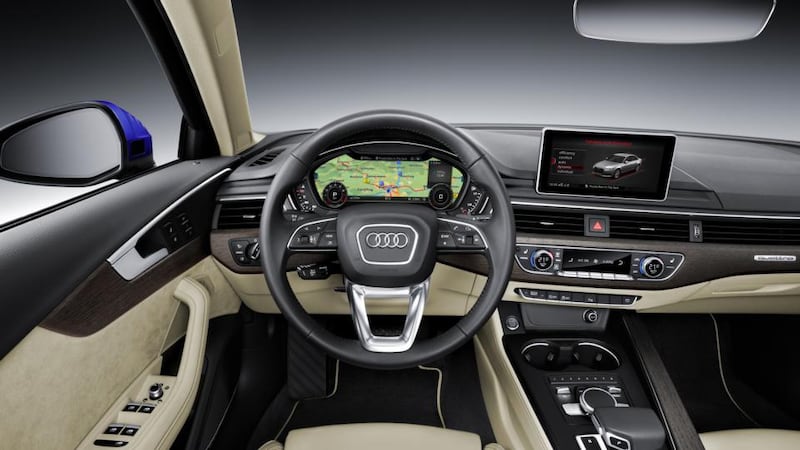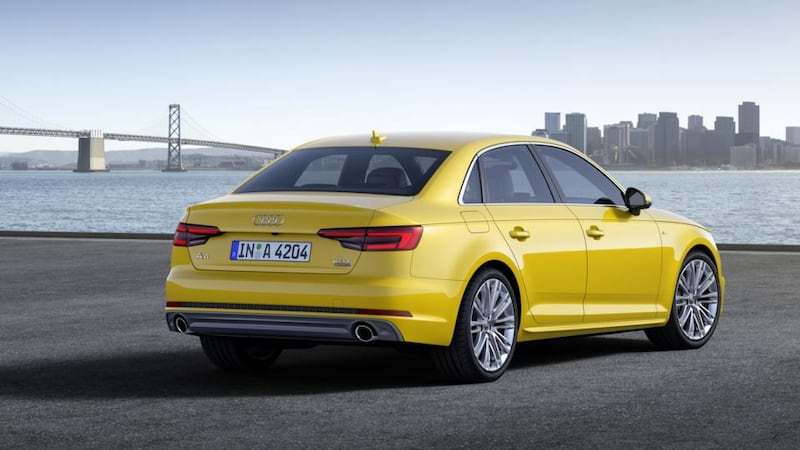Audi has shed more than 100kg from the next-generation A4, making it the most economical of the mainstream German premium mid-sized family cars, even as it gains more luxury, ride comfort and safety equipment.
After seeing the car in the metal last week, I can assure you that as it has an interior that draws its technology from the all-new Q7 this new A4 looks set to become the new class benchmark for quality interiors.
What’s more, the two most economical models fall comfortably beneath the 100-gram barrier for CO2 without the complications, weight or expense of hybrid or plug-in hybrid technology, but that doesn’t mean interesting powertrain tech has been ignored.


A variant of Audi’s 2.0-litre petrol engine, which it calls B Cycle, revives an infrequently utilised engineering quirk to develop 140kW of power and 320Nm but still pulls the fuel economy figure down to only 4.8 litres/100km. (By comparison, BMW’s freshly launched 320i posts 6.0 litres/100km, while Mercedes-Benz’s C250, the most economical of the non-hybrid C-Class models, looks at 5.3 litres/100km.)
That’s not the most economical of the A4 family; with the 2.0 TDI Ultra diesel posting only 3.7 litres/100km and emitting only 95 grams of CO2, though Audi also claims its 3.0-litre V6 TDI just happens to be the world’s most efficient six-cylinder engine, with an economy claim of 4.2 litres/100km.
Audi will launch the new A4 saloon and Avant estate version almost on top of each other, instead of having the usual six-month to one-year delay, with the first European deliveries of each car expected in November or December.
The Avant has shed 120kg thanks largely to lighter engines and gearboxes, along with more aluminium in the body and the use of hot-formed, high-tensile strength steels. The body-in-white weighs 50kg less than the previous version, with the extra weight reduction largely deriving from its switch to an aluminum tailgate.
Everything was targeted for weight savings, which drove the switch from copper wiring throughout the car to aluminium, the use of magnesium for the seat frames and an aluminium-rich mix of materials for the chassis architecture.
The Avant increases its cargo capacity to 505 litres, with a standard 40:20:40 split-fold rear seat that can boost the capacity to 1,510 litres, and a new tailored cubby hole beneath the remarkably flat boot floor to house the puzzle-set cargo holders that used to rob space when they weren’t needed.
Though the body and engineering is all new, it's so conservatively done that you could be forgiven for mistaking the new car for a facelift of the outgoing one. Not so fast, said A4 Technical Project Leader, Burkhard Wiegard.
“It’s more of a three-box sedan now, rather than the old one which was a bit coupe-ish,” he said.
“The grille is a lot lower and wider, the bonnet line is very low - far lower than our rivals could produce - and the total line that runs from the clamshell bonnet through to the tail lights is now the defining visual feature of the profile,” he insisted.
It achieves that low bonnet line by using a pyrotechnic bonnet to taper the nose down into its wider new grille. The new bonnet will use sensors to detect pedestrian impacts, then its pyrotechnic charges detonate, pushing the bonnet line higher (to a preset limit) to give the pedestrians a larger crumple zone before they hit harder points, like the engine or the strut towers.
The front nose of the new A4 is characterised by its bi-Xenon headlights, while there are LED lights as an option (front and rear), while the even-more effective Matrix LED headlights are more expensive again.
The move to more comfort and simplicity started very early, with Audi ditching its three “package” naming strategy, replacing them with just Design and Sport packages.
“The base suspension uses a steel spring, and that’s more comfort oriented than the predecessor in the standard setup,” Wiegard said.
“A lot of people said the old one was too firm, that’s why it’s softer. Then there are two adjustable damper packages as options, but no air suspension. It’s not necessary.
“One active damper suspension option is for comfort, and it’s 10mm lower than the standard ride height. The other is for sport and it’s 27mm lower, but all of them have Audi Drive Select to switch between the modes.”
The hardware behind the suspension options is the same all-new, sophisticated five-link suspension systems at both ends of the car.
The A4’s safety system package is more or less the same as the Q7, which means autonomous city braking is now standard, as are systems to check for cars or cyclists when you open the doors, or when you reverse out of car parks. Plus about another 25 more systems.
One big change is the move to having a fixed multimedia screen on top of the dashboard, which frees up a lot of space beneath it and allows for a shorter dashboard.
“There’s a fixed dash-top MMI screen, because it’s better for the HVAC (heating, ventilation and air conditioning) and the air flow from the vents. It’s a high definition system and a huge screen (7-inch, or 8.3-inch as an option),” he said.
“The standard instrument cluster is analogue, but there is an option for the driver to have a TT-style big screen digital instrument cluster, with a choice of what’s shown there, and there’s also a head-up display option.”
It’s a high-quality interior, with more space in the rear than before and more than 2cm more front headroom.
The infotainment is the same as the Q7 and that means you get Google streetview from closer than 30 metres, and on-line traffic information and social networking, and LTE is the standard connection tool.
The car will run MirrorLink and connects to both iOS and Android smartphones, using Apple Car Play and Android Auto.
The engine lineup begins with the 1.4-litre petrol version of the four-cylinder, turbocharged, direct-injection engine, delivering 110kW of power and 250Nm of torque (from 1500rpm). Audi claims it will slide through to 100km/h in 8.9 seconds and has a top speed of 210km/h.
The base 1968cc turbodiesel delivers 110kW and has 320Nm, while the strongest four-cylinder turbo boosts that to 140kW and 400Nm of torque.
That gets the front-drive base diesel to 100km/h in 8.7 seconds (9.0 seconds with the Avant) and on to a 219km/h top speed. In its standard guise, it posts 3.8 litres/100km (99 grams) as a saloon and 4.0 litres/100km (104 grams) as an Avant.
The stronger of the two diesel fours, with 140kW of power, gets to 100km/h in 7.7 seconds as a front-wheel drive (7.9 as an Avant) and reaches a 237km/h top speed. The Avant reaches 231km/h and uses 4.2 litres/100km, only a touch off the 4.1 litres/100km of the sedan with the same engine.
Then there are the so-called “Ultra” versions of both four-cylinder diesels, which use lower rolling resistance in the tyres, taller gear ratios and even better aerodynamics to pull those consumption numbers down to only 3.7 litres/100km (as a saloon) or 3.8 litres as an Avant, which translates to 95 grams or 99 grams.
Much is riding on the new A4, with its MLB Evo architecture also scheduled to deliver the next RS4 by late 2017, plus the next A5 coupe, convertible and five-door Sportback.










